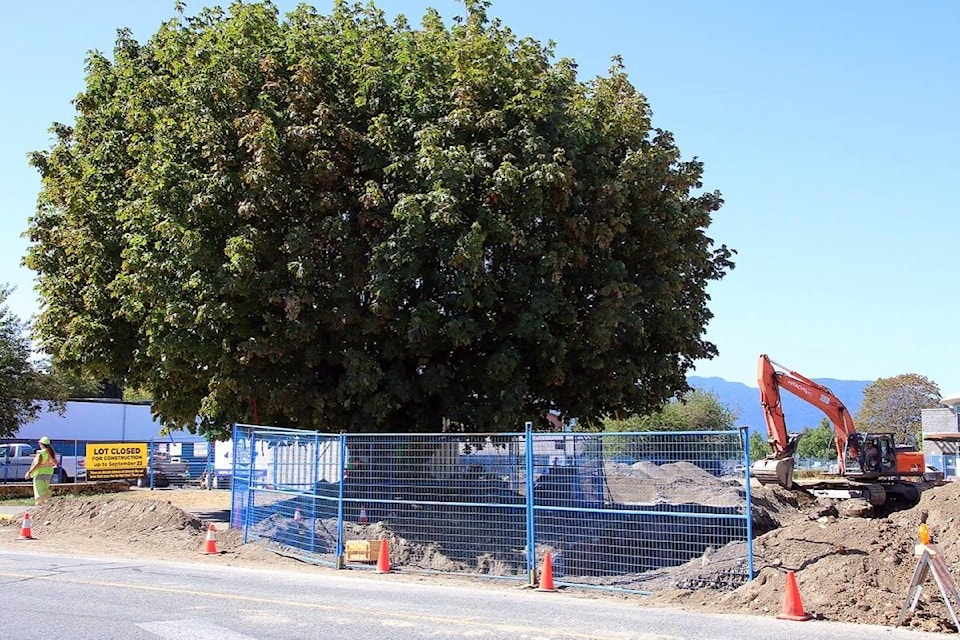Not long ago that we traded a magnificent maple tree at the entrance to the Island Savings Centre for a blandscaped parking lot.
For weeks now there’s been a big fuss going on in Oak Bay over the fate of a 200-year-old oak tree that finds itself in the crosshairs of a proposed condo development.
Numerous letters to the editor, pro and con, and a full-page photo spread in the Times Colonist attest to Victorians’ high regard for trees and heritage which, in this case, combine as one.
But living accommodation, of which there’s a scarcity in the capital city, is also an issue.
What do you suppose are the odds that the oak will be spared by a council that’s going to need the wisdom of Solomon in this particular case? The tree isn’t on the Oak Bay property, it’s on that of the proposed condos’ next door neighbour. But its root structure has crept into the adjoining lot because its owners paved around its base. The new structure is required to have underground parking to meet building bylaws and it’s the construction of same that’ll be the kiss of death for the oak.
Oak Bay council must decide whether to approve the presently empty lot’s zoning, which has existing four-storey condos for neighbours on each side. If they deny the developer a permit in order to save the tree they cause him substantial financial hardship. If they approve a building permit they guarantee the tree’s demise.
The developer, it should be noted, has offered to replace the oak with a “mature six-metre tree” of unspecified species and pay thousands of dollars.
Opinions in the TC’s letters column have been more favourable to the tree but some writers have argued that housing should be a higher priority when Greater Victoria is experiencing a record shortage of accommodation.
In effect, it’s the same old story of human need (or, as is often the case, just human want) vs. environmental and heritage concerns. In this case it’s a high-end condo offering living accommodation; usually the argument is for tax base and employment. But it almost always comes out the same: rightly or wrongly, “people come first,” as a former North Cowichan councillor was fond of saying. Meaning that the environment or a heritage structure almost always lose.
It’s not long ago that we traded a magnificent maple tree at the entrance to the Island Savings Centre for a blandscaped parking lot. Even some of our roundabouts are better foliaged and more attractive.
Now that I have that off my chest, let’s get back to what I’m supposed to be writing about, history. Today’s column is inspired by a lengthy article that appeared in the Cowichan Leader in December 1939. Entitled “Quaint and interesting facts about trees of Cowichan make veritable history of district” (they sure don’t write headlines like that any more, thank goodness), it tells of the first white settlers’ arrival in the Cowichan Valley and their subsequent war against the dense forests that blanketed the land — a herculean struggle of human brawn against the first-growth giants that stood in the way of their creating homesteads.
Theirs was a struggle that few of us can comprehend today in an age where heavy equipment and high explosives can reshape the earth as we please, with the only real considerations being time and cost.
Such wasn’t the case in the 1860s-on when mammoth firs — hundreds of feet tall, several feet in diameter and worth a fortune today — were viewed as an obstacle to be removed by whatever means available: axe, oxen, powder and fire. There was no altruism or idealism involved, just hard reality, without which there’d have been no serious development, no progress as we generally define it. In the words of the anonymous scribe in the Leader: “…Though some may not like it, the cutting of trees, which was necessary to give the new settlement [Duncan] its living space, also brought it most of the prosperity it has to-day… Trees created and still maintain Duncan.”
W.C. Duncan was followed by others, of course, and by the turn of the last century the Duncan townsite was almost devoid of natural foliage but for a handful of mature maples that hadn’t been in the way of construction. One of them, three and a-half feet across, had to be felled in 1939 because it threatened an adjacent house. Another, beside the Christian Science building on Ingram Street (today’s Heritage Building opposite the post office), was still standing then but said to be “sadly cropped” to allow for telephone and electrical power lines.
The James Street tree, rooted on what had been the Evans farm, was perhaps the last of these ancient maples in downtown Duncan. You’ll have to go to the historic Koksilah School to see their like today.
